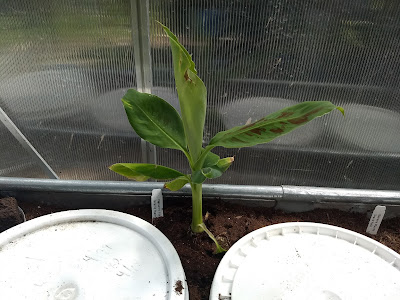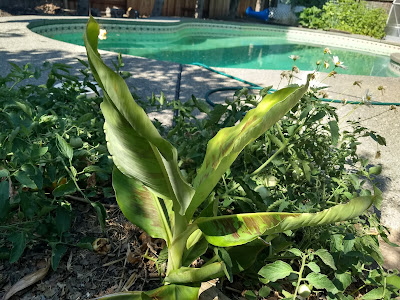After seeing some other people in the neighborhood grow bananas, I felt it was time for me to give bananas a try. I have never tried growing bananas and knew that, given the fact that light freezes can damage the plants, it was a relatively risky proposition to even try to grow them in my climate. Still, I felt that I should try to grow them out.
I
ordered my plants from Florida and grew them out in the greenhouse,
transplanting them out into the garden one at a time, until they all
went into the garden. I chose to try growing the Grand Nain – just
because these seemed easy in relation to the harvest. I felt I had a
good chance of having them make it through the winter if I grew them in
full sun, next to a pool, with jugs of water around them.
Transplanting into the garden when the soil is still cold is a risky proposition. However, there is very little that one can do about this sometimes. I can only change the climate around the plants so much. If they do not thrive, then perhaps they are not suited to my location.
One thing I did that made a huge difference was to apply Bacillus subtilis strain QST 713 to the plants. This used to be called Serenade, but the company that made Serenade was bought out by Bayer. It is also available in 1 gallon quantities, made by BioWorks and sold by Arbico Organics. This stuff is a game-changer. It brought one of my dying banana plants back to life and helped to propagate a whole bunch of pups on another banana plant.
Overall, I would have to say that Grand Nain bananas do not grow very well in my climate – especially compared to some banana varieties that are a little more cold-tolerant. Temperatures of 33 or 34 will often damage the plants, so it is important to plant them in a place where they will be sheltered from these kinds of temperatures. Still – as they have not all perished, I will work to grow these out for one more year and see what happens.
 |
| Making a framework to protect my banana plants |
 |
| Protecting my banana plants from the cold. |






























































































